
a.
To analysis data on renewable energy.
a.
Answer to Problem 64E
Explanation of Solution
Given information:
The table shows the consumption
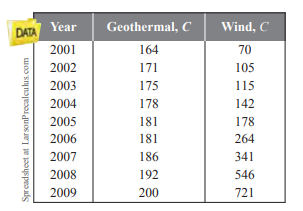

Use a graphing utility to find a cubic model for the geothermal energy consumption data and a quadratic model for the wind energy consumption data. Let
Calculation:
Enter the data in calculator.
Press the button STAT and select EDIT
Enter years in
Then cubic regression is
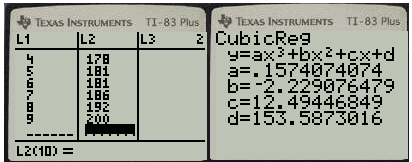
Enter year in
Then quadratic equation is
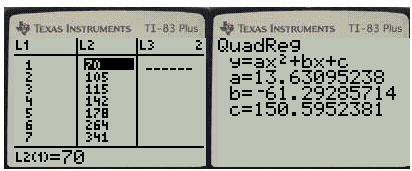
b.
To analysis data on renewable energy.
b.
Answer to Problem 64E
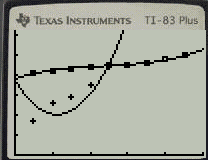
Explanation of Solution
Given information:
The table shows the consumption
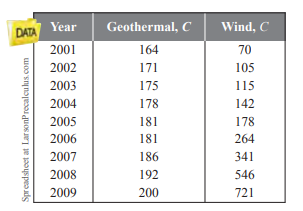

Use the graphing utility to graph the data and the two models in the same viewing window.
Calculation:
Enter the data in calculator.
Press the button STAT and select EDIT
Enter years in
Then cubic regression is
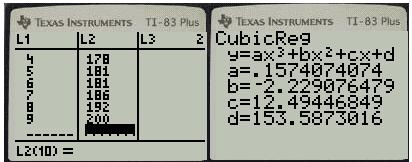
Enter year in
Then quadratic equation is
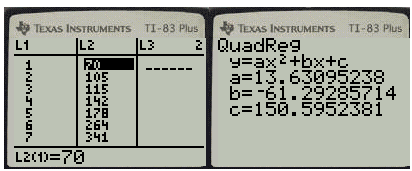
Data and model are shown as,
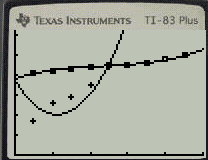
c.
To analysis data on renewable energy.
c.
Answer to Problem 64E
Two curves intercept at
Explanation of Solution
Given information:
The table shows the consumption
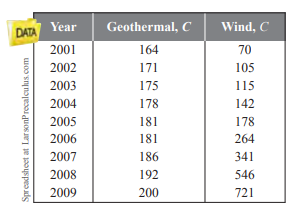

Use the graph from part
Calculation:
Data and model are shown as,
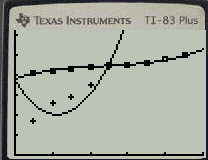
Two curves intercept at
Both consumptions are equal in beginning of the year
d.
To analysis data on renewable energy.
d.
Answer to Problem 64E
We cannot predict the wind energy in the future.
We can predict the geothermal consumption.
Explanation of Solution
Given information:
The table shows the consumption
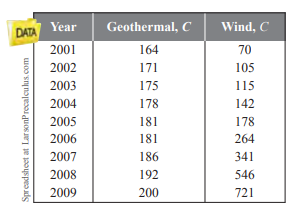

Describe the behaviour of each model. Do you think the models can accurately predict consumption of geothermal energy and wind energy in the United States for future years? Explain.
Calculation:
According to the graph wind consumption model does not fit exact data.
So we cannot predict the wind energy in the future.
And geothermal consumption model fit exact data.
So we can predict the geothermal consumption using the model.
Hence, we can predict the geothermal consumption using the model.
we cannot predict the wind energy in the future.
e.
To analysis data on renewable energy.
e.
Answer to Problem 64E
Calculation:
Advantages:
The use renewable energy is sustainable and will never run out.
Disadvantages:
It is difficult to generate the quantity of electricity as large as produced by traditional fossil fuel generators.
Explanation of Solution
Given information:
The table shows the consumption
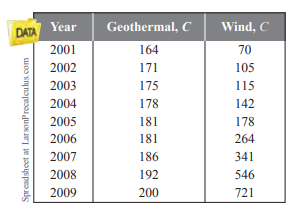

Use your school’s library, the Internet, or some other reference source to research the advantages and disadvantages of using renewable energy.
Calculation:
Advantages:
The use renewable energy is sustainable and will never run out.
Disadvantages:
It is difficult to generate the quantity of electricity as large as produced by traditional fossil fuel generators.
Chapter 7 Solutions
Precalculus with Limits
- 48. f(x) = { 4 x if x < 2 2x 2 if x 2arrow_forwardГ 49. -x+1 if x 1 Answer ->arrow_forwardA Content X MindTap - Cengage Learning x Function Evaluations x + /ui/evo/index.html?elSBN=9780357038406&id=339416021&snapshotld=877369& GE MINDTAP , Limits, and the Derivative ⭑ វា a ANSWEI 16. Refer to the graph of the function f in the following figure. कर्ट AA C 54 -3-2 7 7 Ay 6. S 5. y=f(x) 4 3. 2. 1 -3- 34567 8 00 9 10 a. Find the value of ƒ (7). b. Find the values of x corresponding to the point(s) on the graph of ƒ located at a height of 5 units from the x-axis. c. Find the point on the x-axis at which the graph of ƒ crosses it. What is the value of f (x) at this point? d. Find the domain and range of f. MacBook Pro G Search or type URL + > % Λ & 5 6 7 29 ( 8 9 0arrow_forward
- Morgan F. - C X A Courses MindTap - Cengage Learning Х Domain of Square Roots X + gage.com/static/nb/ui/evo/index.html?elSBN 9780357038406&id=339416021&snapshotld=877369& CENGAGE MINDTAP 2: Functions, Limits, and the Derivative 47. x if x < 0 f(x) = 2x+1 if x 0 Answerarrow_forwardA Content MindTap - Cengage Learning × Function Evaluations * + c/nb/ui/evo/index.html?elSBN 9780357038406&id=339416021&snapshotld=877369& GAGE MINDTAP ions, Limits, and the Derivative 15. Refer to the graph of the function f in the following figure. 6 y = f(x) 5 4+ 3- 2- 1 + 2 -1 3 4 5 6 a. Find the value of ƒ (0). Answer-> b. Find the value of x for which (i) f (x) = 3 and (ii) f (x) = 0. Answer ▾ c. Find the domain of f. Answer + d. Find the range of f. Answer+ MacBook Proarrow_forwardAnswer-> 12. Let g be the function defined by Find g(-2), g(0), g (2), and g (4). - +1 if x <2 g(x) = √√√x-2 if x 2arrow_forward
- 13. Let f be the function defined by Find f (-1), f (0), ƒ (1) and ƒ (2). Answer f(x) = .2 J-x² +3 if x <1 2x²+1 2x²+1 if x ≥ 1arrow_forwardΛ Content Mind Tap - Cengage Learning × Function Evaluations x + c/nb/ui/evo/index.html?elSBN 9780357038406&id=339416021&snapshotld=877369& GAGE MINDTAP ons, Limits, and the Derivative 14. Let f be the function defined by Find f (0), f (1), and f (2). 2+1 x if x 1 if x 1 f(x) = 1 1-xarrow_forwardA Content c/nb/ui/evo/index.html?elSBN 9780357038406&id=339416021&snapshotld=877369& GAGE MINDTAP ons, Limits, and the Derivative 11. Let f be the function defined by Find f (-2), f (0), and f (1). Answer f(x) = [ x² + 1 if x ≤ 0 if x > 0arrow_forward
- Given that 4−4i is a zero, factor the following polynomial function completely. Use the Conjugate Roots Theorem, if applicable. f(x)=x4−5x3−2x2+176x−320arrow_forwardeliminate the parameter to find the cartesian equation of the curve and sketch the graph. On the graph show the direction it takes and the initial and terminal point. Please draw by hand and show how you got to each steparrow_forwardeliminate the parameter to find the cartesian equation of the curve and sketch the graph. On the graph show the direction it takes and the initial and terminal point. Please draw by hand and show how you got to each steparrow_forward
 Calculus: Early TranscendentalsCalculusISBN:9781285741550Author:James StewartPublisher:Cengage Learning
Calculus: Early TranscendentalsCalculusISBN:9781285741550Author:James StewartPublisher:Cengage Learning Thomas' Calculus (14th Edition)CalculusISBN:9780134438986Author:Joel R. Hass, Christopher E. Heil, Maurice D. WeirPublisher:PEARSON
Thomas' Calculus (14th Edition)CalculusISBN:9780134438986Author:Joel R. Hass, Christopher E. Heil, Maurice D. WeirPublisher:PEARSON Calculus: Early Transcendentals (3rd Edition)CalculusISBN:9780134763644Author:William L. Briggs, Lyle Cochran, Bernard Gillett, Eric SchulzPublisher:PEARSON
Calculus: Early Transcendentals (3rd Edition)CalculusISBN:9780134763644Author:William L. Briggs, Lyle Cochran, Bernard Gillett, Eric SchulzPublisher:PEARSON Calculus: Early TranscendentalsCalculusISBN:9781319050740Author:Jon Rogawski, Colin Adams, Robert FranzosaPublisher:W. H. Freeman
Calculus: Early TranscendentalsCalculusISBN:9781319050740Author:Jon Rogawski, Colin Adams, Robert FranzosaPublisher:W. H. Freeman
 Calculus: Early Transcendental FunctionsCalculusISBN:9781337552516Author:Ron Larson, Bruce H. EdwardsPublisher:Cengage Learning
Calculus: Early Transcendental FunctionsCalculusISBN:9781337552516Author:Ron Larson, Bruce H. EdwardsPublisher:Cengage Learning





